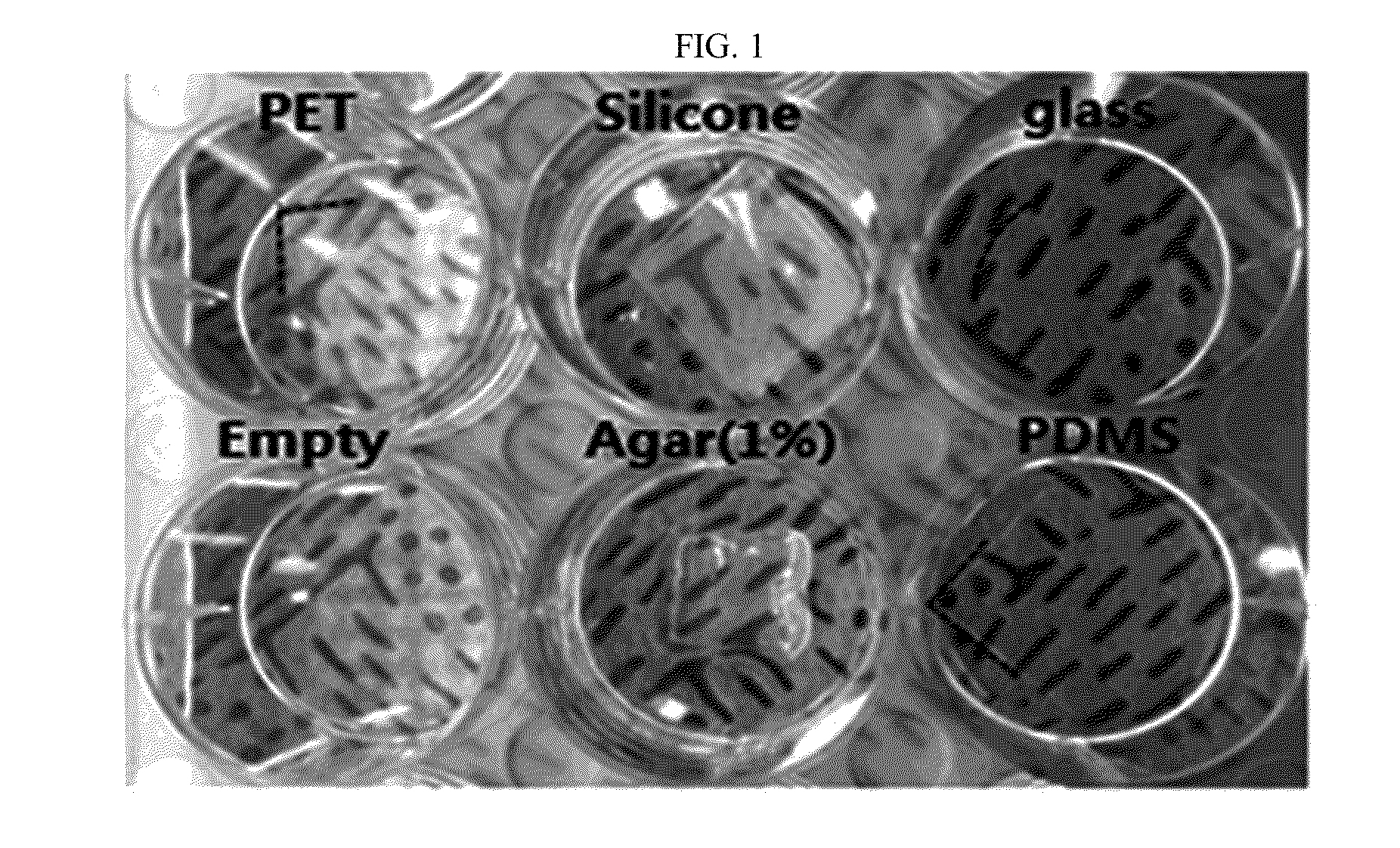Partial skull replacements capable of monitoring in real time and delivering substances into brain tissue, and uses thereof
- Summary
- Abstract
- Description
- Claims
- Application Information
AI Technical Summary
Benefits of technology
Problems solved by technology
Method used
Image
Examples
example 1
Search for Skull Substitute Material
[0062]1-1. Preparation of Substitute Materials
[0063]First, the present inventors searched for a material for a partial skull replacement for long-term monitoring of a surface of the brain within the skull. For this, glass, agarose (at 1% concentration), silicone, polyethylene terephthalate (PET), and PDMS were selected as candidate materials for a partial skull replacement and were each prepared in a cell culture dish (FIG. 1). Later, the cytotoxicity, hydrophilicity, and transparency of the materials were compared and evaluated.
[0064]1-2. Evaluation of Cytotoxicity
[0065]In preparation for an application into biological tissue, the cytotoxicity of the candidate materials for a partial skull replacement prepared in Example 1-1 were evaluated. Specifically, SH-SY5Y cells, which are the human neuroblastoma cell lines, were cultured in cell culture dishes, each of which was treated with each candidate material for a partial skull replacement. 24 hours...
example 2
Preparation of Window by Attaching Artificial Skull Substitute
[0077]The present inventors intended to apply PDMS, which was selected to be most appropriate as the skull replacement material according to the above Example 1, to the skull of a rat.
[0078]As appears in FIG. 5, skin in the area corresponding to biological tissues to be observed by visualization was removed to cause the skull to be exposed (blue dot lines in FIG. 5A and FIG. 5B), and then, the skull was removed with a drill (FIG. 5C) to exposure brain under the skull. Then, meninges on the cortex was removed with a pair of fine forceps, and, before the brain expanded as a result of the removal of meninges, an artificial partial skull replacement consisting of PDMS with an appropriate thickness was applied on the cortical tissue, and attached, with an instant glue, to the skull in the affected area (FIG. 5D and FIG. 5E). Lastly, a dental resin was used to seal and cover all of the connection between the artificial partial ...
example 3
Confirmation of Excellence of Artificial Skull Substitute in Biological Tissue Monitoring
[0079]A cross-section of the skull to which the artificial partial skull replacement is attached according to Example 2 is provided the schematics in FIG. 6. As shown in FIG. 6, the artificial partial skull replacement cranial window of the present invention has a flexible form, which enables the partial skull replacement to be attached to the skull of a rat for the long-term monitoring of the brain and a biological structure within the skull in real time. The following experiments were conducted with the intention of confirming the above statement.
[0080]3-1. Evaluation of Stability of Brain Surface Tissues and Blood Vessels
[0081]Brain tissue and blood vessels within the skull were monitored for any change for a long period of 10 weeks from the day the artificial partial skull replacement was attached. As shown in FIG. 7, the results show that conditions enabling the observation of brain surface...
PUM
| Property | Measurement | Unit |
|---|---|---|
| Pressure | aaaaa | aaaaa |
| Area | aaaaa | aaaaa |
| Biological properties | aaaaa | aaaaa |
Abstract
Description
Claims
Application Information
 Login to View More
Login to View More - R&D
- Intellectual Property
- Life Sciences
- Materials
- Tech Scout
- Unparalleled Data Quality
- Higher Quality Content
- 60% Fewer Hallucinations
Browse by: Latest US Patents, China's latest patents, Technical Efficacy Thesaurus, Application Domain, Technology Topic, Popular Technical Reports.
© 2025 PatSnap. All rights reserved.Legal|Privacy policy|Modern Slavery Act Transparency Statement|Sitemap|About US| Contact US: help@patsnap.com



